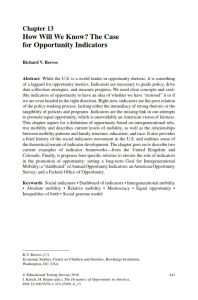Únase a getAbstract para acceder al resumen.

Únase a getAbstract para acceder al resumen.
Richard V. Reeves
How Will We Know? The Case for Opportunity Indicators
Brookings Institution, 2016
¿De qué se trata?
“Opportunity indicators” could measure and advance people’s upward income mobility.
Recommendation
While the United States often bills itself as “the land of opportunity,” the metrics for laying claim to that coveted title are often muddled and murky. Even as politicians remain behind battle lines on critical issues, almost all of them agree that upward income mobility has stalled. At one time, Americans could reasonably expect to achieve a better economic status than the one into which they were born. That’s no longer necessarily so. Writer Richard V. Reeves explores the ways government can use available data to measure income progress while aiming at specific opportunity targets. getAbstract recommends this thought-provoking paper to social scientists, economists and government decision makers interested in gauging social and economic mobility.
Summary
About the Author
Richard V. Reeves is a writer and a senior fellow at the Brookings Institution.





















Comment on this summary